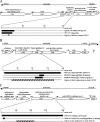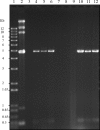A genetic determinant in Streptococcus gordonii Challis encodes a peptide with activity similar to that of enterococcal sex pheromone cAM373, which facilitates intergeneric DNA transfer
- PMID: 20233933
- PMCID: PMC2863574
- DOI: 10.1128/JB.01689-09
A genetic determinant in Streptococcus gordonii Challis encodes a peptide with activity similar to that of enterococcal sex pheromone cAM373, which facilitates intergeneric DNA transfer
Abstract
Enterococcus faecalis strains secrete multiple peptides representing different sex pheromones that induce mating responses by bacteria carrying specific conjugative plasmids. The pheromone cAM373, which induces a response by the enterococcal plasmid pAM373, has been of interest because a similar activity is also secreted by Streptococcus gordonii and Staphylococcus aureus. The potential to facilitate intergeneric DNA transfer from E. faecalis is of concern because of extensive multiple antibiotic resistance, including vancomycin resistance, that has emerged among enterococci in recent years. Here, we characterize the related pheromone determinant in S. gordonii and show that the peptide it encodes, gordonii-cAM373, does indeed induce transfer of plasmid DNA from E. faecalis into S. gordonii. The streptococcal determinant camG encodes a lipoprotein with a leader sequence, the last 7 residues of which represent the gordonii-cAM373 heptapeptide SVFILAA. Synthetic forms of the peptide had activity similar to that of the enterococcal cAM373 AIFILAS. The lipoprotein moiety bore no resemblance to the lipoprotein encoded by E. faecalis. We also identified determinants in S. gordonii encoding a signal peptidase and an Eep-like zinc metalloprotease (lspA and eep, respectively) similar to those involved in processing certain pheromone precursors in E. faecalis. Mutations generated in camG, lspA, and eep each resulted in the ablation of gordonii-cAM373 activity in culture supernatants. This is the first genetic analysis of a potential sex pheromone system in a commensal oral streptococcal species, which may have implications for intergeneric gene acquisition in oral biofilms.
Figures




Similar articles
-
Streptococcal peptides that signal Enterococcus faecalis cells carrying the pheromone-responsive conjugative plasmid pAM373.Mol Oral Microbiol. 2019 Dec;34(6):254-262. doi: 10.1111/omi.12271. Epub 2019 Oct 29. Mol Oral Microbiol. 2019. PMID: 31610092
-
Streptococcus gordonii pheromone s.g.cAM373 may influence the reservoir of antibiotic resistance determinants of Enterococcus faecalis origin in the oral metagenome.J Med Microbiol. 2017 Nov;66(11):1635-1639. doi: 10.1099/jmm.0.000613. Epub 2017 Oct 12. J Med Microbiol. 2017. PMID: 29022550 Free PMC article.
-
Enterococcus faecalis conjugative plasmid pAM373: complete nucleotide sequence and genetic analyses of sex pheromone response.Mol Microbiol. 2000 Sep;37(6):1327-41. doi: 10.1046/j.1365-2958.2000.02072.x. Mol Microbiol. 2000. PMID: 10998166
-
The sex pheromone system of Enterococcus faecalis. More than just a plasmid-collection mechanism?Eur J Biochem. 1994 Jun 1;222(2):235-46. doi: 10.1111/j.1432-1033.1994.tb18862.x. Eur J Biochem. 1994. PMID: 8020463 Review.
-
Peptide pheromone-induced transfer of plasmid pCF10 in Enterococcus faecalis: probing the genetic and molecular basis for specificity of the pheromone response.Peptides. 2001 Oct;22(10):1529-39. doi: 10.1016/s0196-9781(01)00489-2. Peptides. 2001. PMID: 11587782 Review.
Cited by
-
Bacteria Modify Candida albicans Hypha Formation, Microcolony Properties, and Survival within Macrophages.mSphere. 2020 Aug 5;5(4):e00689-20. doi: 10.1128/mSphere.00689-20. mSphere. 2020. PMID: 32759336 Free PMC article.
-
An ABC transporter is required for secretion of peptide sex pheromones in Enterococcus faecalis.mBio. 2014 Sep 23;5(5):e01726-14. doi: 10.1128/mBio.01726-14. mBio. 2014. PMID: 25249282 Free PMC article.
-
Impact of Polymicrobial Infection on Fitness of Streptococcus gordonii In Vivo.mBio. 2023 Jun 27;14(3):e0065823. doi: 10.1128/mbio.00658-23. Epub 2023 Apr 12. mBio. 2023. PMID: 37042761 Free PMC article.
-
Antagonistic Donor Density Effect Conserved in Multiple Enterococcal Conjugative Plasmids.Appl Environ Microbiol. 2016 Jul 15;82(15):4537-45. doi: 10.1128/AEM.00363-16. Print 2016 Aug 1. Appl Environ Microbiol. 2016. PMID: 27208137 Free PMC article.
-
A bacteriocin-based treatment option for Staphylococcus haemolyticus biofilms.Sci Rep. 2021 Jul 6;11(1):13909. doi: 10.1038/s41598-021-93158-z. Sci Rep. 2021. PMID: 34230527 Free PMC article.
References
-
- Andremont, A. 2003. Commensal flora may play key role in spreading antibiotic resistance. ASM News 69:601-607.
-
- Baker, G. C., J. J. Smith, and D. A. Cowan. 2003. Review and re-analysis of domain-specific 16S primers. J. Microbiol. Methods 55:541-555. - PubMed
-
- Bendtsen, J. D., H. Nielsen, G. von Heijne, and S. Brunak. 2004. Improved prediction of signal peptides: SignalP 3.0. J. Mol. Biol. 340:783-795. - PubMed
Publication types
MeSH terms
Substances
Grants and funding
LinkOut - more resources
Full Text Sources

